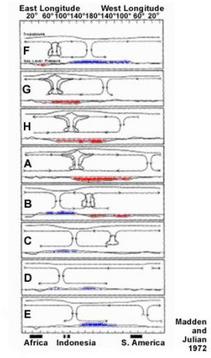
The Madden-Julian Oscillation is a mode of sub-seasonal atmospheric variability that influences the location and strength of tropical precipitation as in this classic schematic (left)
 |
The MJO was first described in 1971 but a field project held over the west equatorial Pacific during 1992-93 raised awareness of the MJO as a coherent phenomenon, possibly useful for weekly predictions of tropical precipitation and extratropical weather patterns. The MJO is best defined over the oceanic warm pool, which extends from the Indian Ocean to the central Pacific and where complex variations of precipitation occur from day to day. The warm pool is generally defined by sea surface temperatures that are > 28C. As a result of this intense activity, the MJO is sometimes difficult to see in a sequence of satellite pictures of the Tropics. This link shows a satellite animation of a strong MJO that occurred during December 2003 to January 2004. Note the non-steady or transient nature of the convection, some of which can be seen more clearly when the data are averaged in space or time. Ways to monitor the MJO are illustrated later.
b) How can an MJO affect the weather?
When an MJO moves eastward through the Indo-Pacific Ocean region, it produces large, slowly changing departures from the normal tropical precipitation. These departures change the atmospheric circulation and, through the phenomenon of Rossby wave dispersion, the changes can propagate into higher latitudes. The accompanying picture
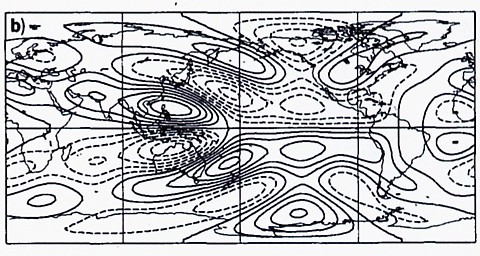 |
| Rossby Wave Propagation |
c) How do MJOs interact with slower climate processes like ENSO?
MJOs may play a role in the transition to an El Nino or La Nina.This means they help determine details of the timing and/or amplitude of a warming or cooling event. However, the transitional stage of an ENSO event is complicated and the MJO's role is still being investigated. MJOs were prominent during the 1996-97 northern winter at the early stage of the 1997-98 El Nino and this led to heightened awareness of a possible MJO-ENSO link.The 1996-97 MJO activity was by some measures the greatest in the ~30 year record of outgoing longwave radiation (OLR, a proxy for deep tropical convection). On the other hand, 1997-98 had the weakest activity in the record.The two years are contrasted here using a time-longitude or Hovmoller diagram of total OLR for 1996-97 and 1997-98
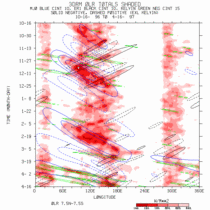 |
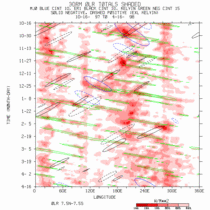 |
| 1996-97 OLR | 1997-98 OLR |
Once SST anomalies associated with an ENSO are in place, the MJO life cycle is influenced by the SST anomalies. When or if an MJO develops, the simplest effect during El Nino is a farther eastward movement of the convection into the central Pacific whereas during La Nina the convection anomalies barely get into the western Pacific. In both cases the MJO still "starts" over the Indian Ocean.
Despite this influence on the MJO life cycle, it is
unclear whether overall MJO activity is influenced by the phase of the
ENSO cycle. The natural variation of MJO activity is too large and observed
datasets are too short to provide a definitive answer to this question.
Transient convection at all time scales increases when sea surface temperatures
(SST) reach ~ 29C (84F). On the other hand, there is a significant relationship
between MJO activity and SST anomalies over the western Pacific Ocean (140-180E).
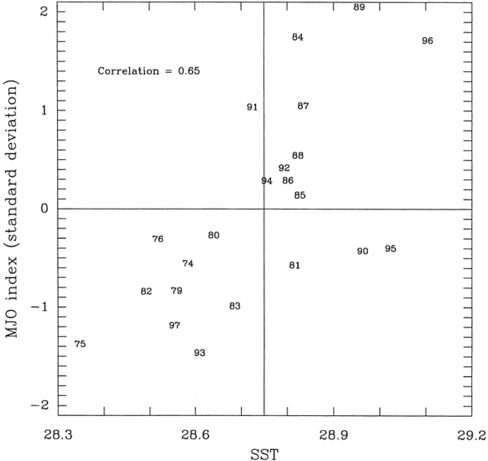 |
| Scatter plot of SST vs. MJO activity |
d) How can the atmosphere and ocean signals associated with the MJO be determined?
The MJO life cycle can be broken down into stages using an index based, for example, on the location of the MJO's tropical convection anomaly. The atmosphere's observed large-scale circulation and/or local weather anomalies can then be averaged over many cases to produce a "composite" `anomaly for each stage. Time filtering is usually applied to exclude higher and lower frequency variability. The results produce an estimate of the MJO signal or influence based on the observational record. The composite anomalies of circulation and weather are generally weak in the extratropics and moderately strong in the tropics and subtropics. They will be described in more detail later.
e) How do MJOs interact with faster weather processes like synoptic scale waves and wavetrains?
The composite anomalies, assuming they are statistically significant and large enough, produce persistent (1-3 week) changes in the atmospheric flow due to the MJO. These changes can influence the development and propagation of synoptic-scale weather systems, i.e. they influence the storm track. For example, during one stage Pacific Ocean storms tend to be stronger and farther south when they make landfall on the U.S. west coast. At the opposite stage the storm or wave energy may split and move south into the tropics and north into Canada, favoring storms over the central U.S. Plains. Because the MJO extratropical signal is weak there are large variations of the actual circulation or weather observed in individual cases. Other processes may overwhelm or mask the MJO signal.
Daily monitoring of many individual cases has produced qualitative evidence for interaction between the circulation induced by flare-ups of convection within the MJO's convective envelope and synoptic scale waves or wavetrains passing by in mid-latitudes and the subtropics. These daily interactions are large amplitude and sometimes contribute to the rapid initiation of the composite MJO signal and/or major transitions in weather patterns.Until GCMs are able to simulate MJOs, we rely on daily monitoring and a subseasonal synoptic model to provide an early indication of such situations.
f) How is the MJO signal extracted from climate forecasts?
This section will discuss how the MJO signal is pulled from models
and forecasts. Ideally, the MJO signal in the forecasts in the group will
be displayed here. Advantages and disadvantages of the different methods
will be discussed.
Project on EOFs